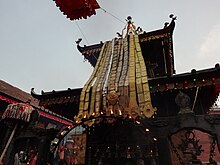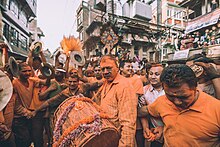This article has multiple issues. Please help improve it or discuss these issues on the talk page. (Learn how and when to remove these messages)
|
| Siddhikali Temple सिद्धिकाली मन्दीर | |
|---|---|
 | |
| Religion | |
| Affiliation | Hinduism |
| District | Bhaktapur |
| Location | |
| Location | Thimi |
| Country | Nepal |
The Siddhikali Temple is a Hindu temple located in Thimi, Nepal.[1] The two-storey roofed temple is dedicated to Kali, Shiva and Ganesh. It is also believed that this Shaktipeeth was formed the fallen right eye of Sati's corpse. This place is located in Inayekwo, in the north west of Thimi.[2] The temple is also known as Inayekwo Dyo in the Nepalese Bhasa language. The Siddhikali Temple is also known as Chamunda, one of the goddesses of Astamatrika. The majestically impressive Siddhikali temple has numbers of Pataa streaming down the front. There is a Satah (rest-house) opposite to the temple and multiple Falcha (Inns) and several smaller shrines (Bhairav, Shiva Temple, Saraswati Temple, Bhimsen Temple, Basundhara Temple, Sahsrabhuj Lokeshwor Temple, Buddha Chaitya) to the rear and nearby, and several stone taps around the place.


The Siddhikali Temple or Siddhi Kali Temple is a cultural and religious place. Inside the temple, Siddhikali and Ganesh can be easily recognized in the middle part. Besides that, the deities Bhairav and Navadurga also exist inside the temple. In Chapacho Thimi, there is Siddhikali Dyo Chhen (meaning House of God) where people can worship Siddhikali. The Jatra of goddess Siddhikali starts and ends here. Twice in a year, (Baisakh 1 and Yenya Punhi) Siddhikali takes to the Siddhikali temple from Dyo chhen to observe the Jatra known as Dyo Bwekegu Jatra. A statue of Ganesh is kept on Dyo Chhen and the chariot during Biska Jatra (Bisket Jatra) (Baisakh 1st and 2nd) and Yenya Punhi Siddhikali Jatra.

Siddhikali temple is a Shaktipeeth and holy pilgrimage place situated on the outskirts of the old city of Thimi in Bhaktapur District. There are two traditional gates (Dhwakha) to enter the city from the Siddhikali temple. In the past, a residential area only started from the gate. One Dhwakha was near to Nasanani Tole, which was totally vanished, and another is near to Dwoda Tole, which is the nearest residential area from temple. Beside that, there are two newly-built entrance gates near the temple.
The premises of the Siddhikali temple have more than 10 traditional Lhon hiti (stone taps) and two ponds. Still, most of the stone taps have natural water flowing continuously. Most of the Lhon hiti have their own name, like Dhwo hiti, Poo hiti, Nasa hiti, Dathu hiti, and Patawal hiti.
It is believed that Siddhikali fulfills the wishes of devotees. Everyday, lots of devotees visit the temple. Tuesday and Saturday are the special days to worship Siddhikali on. On most Tuesday and Saturday nights, people came here to worship and light the diyo of Itaa (a type of diyo made by cotton and oil) around the temple. This is called Chaakamataa Chyakeu in the Newa language. Devotees light the diyo with oil around the temple.
The Nitya Bhajan is performed everyday in the morning and every Saturday night. Ramayan Bhajan is performed every Friday mid-day in the Siddhikali Temple.
There are numbers of Pataa (a long metal hanging from top of temple to front) in the Siddhikali temple. Most of the Pataa are offered from devotees to show their deep belief in Siddhikali.
The Khuchaa (small river) is passed through the temple premises. A Bhimsen Temple is located on the bank of that Khucha, on the west side of the Siddhikali temple. That was a pilgrimage site known as Bishnuganga, also called Bhimghat. In the past, often crying babies were often brought there to have their face washed. It is believed that the babies would often stop crying after having their face washed with water from that river. People from the north part of Thimi still came here to offer and flow Pinda to their ancestors after completing Shradhha (a special worship of ancestors mostly done annually on their death date).
A Mahadev temple is located near to Bhimsen Temple, which is known as Gopaleshwor Mahadev.
On the east part of Siddhikali temple, there is a small hill known as Kutunga. It is believed that while the Sanjivani hill was being carried by Hanuman, some part of Sanjivani hill fell down there. Kutunga means "fallen hill" in the Newa language.
On the day of Gathemangal- Gathamuga chaturdashi, 3 different Gathamuga are pulled out to the bank of the Khucha near to the Siddhikali temple and burn it there. Every year, 3 Gathamuga from Nasanani Tole, Digu tole and Wachunani-Kumanani Tole of Thimi are pulled to the riverbank. Gathamuga chaturdashi is a unique festival where festivals of the Newa people start.
During the Dashain festival, on the day of Fulpati, the Fulpati (an assortment of different plants and flowers) is brought from Siddhikali temple to Layeku Taleju temple of Thimi and Khadga Jatra (Khaan Pyaa Woigu) is celebrated on the next day of Bijaya Dashami in Balkumari temple premises.

Siddhikali Jatra is celebrate twice in a year. Once in Baisakh month known as Biska Jatra and another in Bhadra month known as Yenya Punhi Jatra. On the day of Yenya punhi night, goddess Siddhikali is taken to temple from Dyo Chhen (God house) which is called Dyo Bwekegu Jatra. A special worship is done in temple then returned to Dyo chhen again. During Dyo Bwekegu Jatra, only Dyo Bwekegu beats is played in Dhime Baja (drum type musical instrument). On the next day, pratipada tithi night Siddhikali jatra is celebrated within Siddhikali Jatra route (traditional route of siddhikali jatra) by carrying the Palanquin, playing Dhime, Bhusya and carrying Chilakh (special type oil lamp). Siddhikali jatra is started from Dyo Chhen and makes rounds in Thimi core area and ends at Dyo Chhen again.
On Biska Jatra (Bisket Jatra), 1st of Baisakh morning, Dyo Bwekegu jatra is performed by taking the goddess Siddhikali from Dyo Chhen to temple. Baisakh 1st is the big day for Thimi locality. On this day A puja is offered whole day. Most of people from Thimi visit the temple to worship. On evening of the day a big jatra of Siddhikali Gan is celebrated in temple premises. Seven palanquins of Siddhikali Gan (Siddhikali, Koshi Inaye Ganesh, Bishwo Binayak, Korki Inaye Ganesh, Gaancha Inaye Ganesh, Raj Ganesh and Shiwa Ganesh) are gathered together and celebrate a big Biska Jatra in Siddhikali temple premises, it is also known as Siddhikali Jatra and Byalisiya Jatra. The crowds, sounds of Dhime and Bhusyas, Naya khin, vermilion color, fires on Chilakh, seven palanquins and rounding Chhatra are the best moments of the jatra. The Jatra will take round the Thimi upper part too. On Baisakh 2nd morning 19 palanquins are gathered together with Siddhikali Gan in Balkumari temple premises to celebrate Suthasiya Biska Jatra/Balkumari Jatra and makes round of Thimi city.

In Baisakh 1st Biska Jatra 7 palanquins are gathered together in temple premises. But one palanquin (Bishwo Binayak) will not cross the Dhwakha (traditional gate to enter the city) of temple premises and stops near the Dhwakha and other all palanquins will take to temple and round the Siddhikali temple. On the left side of Siddhikali temple there is a Lhon hiti (stone tap) which still has a supernatural power. It is believed that, the stone tap has Gholi Naag and the Aasan (throne) of Bishwo Binayak has also Gholi Naag. Both Gholi Naag should not meet each other so the palanquin of Bishwo Binayak stops near to Dhwakha and will not cross that Dhwakha.
There are numbers of Guthi related to Siddhikali Jatra from ancient period. Each Guthi has their own responsibility during the jatra period. Siddhikali Dyo Guthi, Siddhikali Moo Dhime Guthi, Siddhikali Dhime Guthi, Chhatra Guthi, Nol Guthi, Sinha Guthi, Falcha Guthi, Dalbu Guthi, Siddhikali Basuri Khala are the some guthis related to Siddhikali Jatra.

Moo Dhime is a special Dhime in whole Thimi city. It is played with one Dhime only where other Dhime are played in groups with numbers of Dhime. A single Dhime with more Bhusya, Chwamo (Chamar) and Pankha in Biska jatra is the one of main attraction of Biska Jatra (Bisket Jatra). This Dhime is played outside only two days (Baisakh 1 and 2nd) in a year. Rest of days it is kept on hanging in Moo Dhime Chhen. Only after the arrival of Moo Dhime in jatra, the palanquin of Siddhikali is carried out. So that it has a major role during Biska jatra. This Dhime is called the symbol of Naag. The beats of this Dhime is totallay different and unique from other common Dhime beats. The Moo Dhime beats are not allowed to play by other common Dhime in jatras and in any occasions. Moo Dhime Guthi is formed to protect and play the Dhime in Biska Jatra.
The major festivals celebrated in Siddhikali Temple premises are Biska Jatra / Bisket Jatra ( Last days of Chaitra month, Baisakh 1st and Baisakh 2nd), Digu puja, Gathemangal, Yenya punhi Jatra, Mohani (Dashain), Bala Chaturdashi, Shree Panchami/Vasant Panchami, Bhim Dwadashi, Holi Purnima and Maha Shivaratri.
- ^ "Reconstruction of Siddikali temple begins". The Himalayan Times. 2007-12-25. Retrieved 2017-12-05.
- ^ "Police draw blank in idol theft case". Kathmandpost.ekantipur.com. Retrieved 2017-12-05.
- ^ "Thimi: the forgotten heritage town in Kathmandu". Thelongestwayhome.com. 19 October 2016. Retrieved 2017-12-05.
- ^ "kathmandu-valley-temples.com". Kathmandu-valley-temples.com. Retrieved 16 December 2017.
- ^ "SiddhiKali Temple, Thimi". Facebook.com. Retrieved 16 December 2017.
- ^ "साधनाले हुर्काएको सांस्कृतिक सम्पदा". annapurnapost.com. Retrieved 28 December 2019.